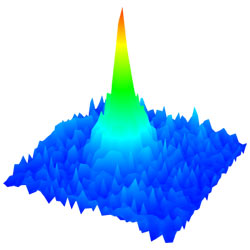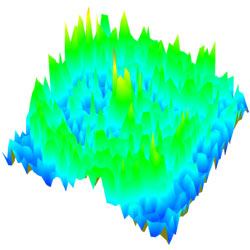Focusing Sound without a Lens

Ideally, the material in your apartment wall reflects the sound waves of your neighbor’s loud music away from your living space, or at least transmits them at a much lower level. Most materials act this way, but in the 9 July PRL researchers present a “phononic crystal” with decidedly different characteristics. A slice of this stuff can bend sound waves into a tight focus. Although the crystal wouldn’t be good for walls, this “negative refraction” phenomenon could lead to better ultrasound imaging devices, which can view a developing fetus or find hidden cracks in an oil pipeline.
Over the past decade or so, researchers have developed so-called phononic materials, which can block specific frequencies of sound. John Page of the University of Manitoba, Canada, and his colleagues, created a simple phononic crystal by immersing in water an array of 0.8-millimeter-diameter tungsten carbide beads, precisely stacked in an arrangement that resembles oranges in a crate. Sound waves in a frequency range centered at 1 megahertz, where the wavelength is close to the diameter of the beads, cannot penetrate this structure. The easiest way to understand this “band gap,” says Page, is to think of acoustic waves scattering off the dense beads. The bead size and arrangement ensures that every peak in the scattered waves is met by an identical trough that cancels it out, a process known as destructive interference.

Surprises emerged when the researchers looked at the crystal’s effect on ultrasound frequencies above the forbidden range. Sound waves at 1.60 megahertz, generated by a small source placed just above an 8-millimeter-thick slab of the crystal, continued to spread out as they passed through the phononic material. But sound waves just slightly lower in frequency, at 1.57 megahertz, behaved in quite the opposite way–the crystal bent them back toward a focal point just below the slab.
This negative refraction–bending of a wave in the “wrong” direction–arises from essentially the same kind of interference process that creates the band gap at lower frequencies. In this case, the destructive interference occurs for waves traveling in most directions, but not for those ultimately heading toward the focal point. The interference pattern changes dramatically for a small change in frequency, unlike in ordinary materials, where changes in the patterns would be more gradual. The researchers created a theoretical model of the propagation of signals through the crystal and got “tremendous agreement” with the experimental results, says Page.
Ultrasound imaging ordinarily uses lens-shaped objects that bend acoustic waves in a way similar to lenses used for light. But Page says phononic crystals may offer improved image resolution at scales close to the wavelength of the ultrasound oscillations–typically 1 millimeter or less–where conventional ultrasound imaging begins to fail. Doctors use ultrasound imaging to diagnose heart problems and fetal development; engineers use them to hunt for defects in oil pipelines and the wings of fighter jets.
“The results are impressive,” says John Pendry of Imperial College, London. The first demonstration of negative refraction for light “caused quite a stir,” he recalls, but he says there is now no doubt that the phenomenon occurs (see Focus, 3 May 2002). It’s not a surprise that negative refraction can also occur for acoustic waves, he adds, but that doesn’t mean the experimental proof was easy. “These guys have done a first-class job.”
–David Lindley
David Lindley is a freelance science writer, now retired. His most recent book is The Dream Universe: How Fundamental Physics Lost Its Way (Penguin Random House, 2020).
More Information
Focus story on negative refraction of light from 3 May 2002


